by Ilan Garibi and Gadi Vishne and Eyal Reuveni
It took some time, but we knew - we must do something special for our 10th paper review!
Our reviews are all about getting to know different paper types and with hands-on experience reviewing their strengths and best areas for use. But we - Ilan and Gadi - are only two folders, so our reviews summarize only our point of view. And we know there are better folders than us out there. So we decided to approach a great folder, one of the best, and ask for his opinion on each of the papers we reviewed so far.
We wanted to set only minimal restrictions, namely that the papers were to be reviewed by folding the same model from the different paper types. The folder was free to choose which model he'd review the papers with. He could also pick a suitable paper size for each paper type, and paint and treat it as he thought fit. Then he was to conclude what he thought of each paper.
Having this idea, we started our search for a master folder, one with enough patience to fold the same model ten times. Luckily, we did not have to look far. We found the right candidate in our home country, in Israel.
The Folder
Let us introduce Eyal Reuveni, an Israeli folder. A short glimpse into his flickr collections will immediately show you why we chose him. He is one of the best technical folders in the world. He has folded numerous complex models, often several copies - be it from diagrams or CP. Great creators share their diagrams with him before publication to hear his opinion and to fix problems he finds.
Eyal started to fold at the tender age of ten, discovering origami with Robert Harbin's books. For many years he folded animals and insects from Montroll and Lang books. Later on, being exposed to many new creators through the internet, he fell deeper and deeper into the world of paper and complex origami. Looking for challenges, he started to decipher crease patterns in order to fold the most complicated models.
"I am attracted to the highly realistic models, with all the tiny details", he says. Today he lives in Shoham, Israel, in a house packed with thousands of models. Although he did create a few models, he prefers to focus on folding other people's models, the more complex - the better. His most admired creators are Satoshi Kamiya and Hideo Komatsu from Japan.
He also teaches origami, techniques and paper treatments.
Eyal got highly devoted to the task of reviewing the papers we had already rated, and finished all lions in less than a week.
The Papers
Elephant Hide
100gsm, 45×45cm, original color of golden brown
Despite the thickness of this paper, it is the best paper for the lion, as well as most of Komatsu's models in general. Some steps were quite difficult to fold, but for that reason I chose this size of paper. The texture of this particular paper is wonderful, and the paper enabled me to shape it perfectly, without using wet folding, MC or any other treatment.
Tant
78gsm, 35×35cm, original brown color
This is one of my favourite papers and it is very good for animal folds, as the texture is highly suitable for that. Because of that, folding the lion with Tant was much more fun than most papers. Still, it is necessary to be very careful, since it might rip in the edges. I had to unfold the model partially before completing the base of the lion, in order to make some tricky sinks, and layers’ wrapping, steps that later on form the back legs and the mane. Shaping the finished model was easily done using a thin wooden role or the tip of a painter's paintbrush, and, like with Elephant Hide, without any special treatment to the paper.
Japanese Foil
50gsm, 35×35cm, silver foil and white side colored
I do not like folding with this paper. It is best to use it when glued to another paper (tissue, mostly). It was very challenging to fold the lion with Japanese Foil, since it wears down easily, and it is very difficult to reverse the creases. I painted the white side using acrylic water-based paint by “Folk Art” to change the white to copper color. It is necessary to fold very carefully and perfectly if you want to avoid the metallic foil side to be seen in the final model. The advantage is how easy it can be shaped, and how it holds this shape. The finished lion is very delicate and light.
Copy / Printer Paper
80gsm, 42×42cm, original color of white
I hardly ever fold from copy paper, besides test folding crease patterns. Luckily, this particular paper has a better quality than the usual copy paper. It was a bit challenging to make sinks and un-sinks without tearing the paper, but I managed to do it. Like Tant, it was necessary to unfold the paper partially to go through the rough stages of forming the inside layers of the back legs and creating the mane. Last touches of finishing were easy to make using my fingers to shape the mane. (IG: this is indeed a premium copy paper from Hadera Paper Mill).
Origamido®
40gsm, 35×35cm, original color of blue, colored
This is my first time folding from this expensive, high quality paper. I think it is best for folding insects and super complex models, and not for animals such as this lion. In order to make the paper easier to work with, and to enhance the texture, I applied water-based acrylic varnish. The paper is very strong and doesn’t rip easily. Still, it is not easy to fold a 3D animal from it. I had to partially unfold some steps in order to make close sinks doable. Shaping the lion was easy and the final model looks very nice (although a brown color would be more suitable). (IG: Origamido® was not meant to be used this way. Name your model and the manufacturer will prepare the right paper for you. Here we had to use what we had, a blue thin paper).
Stardream
120gsm, 42×42cm, original orange color
I really like folding from this paper, in spite of its thickness (120 grams!!). Folding such a complex model was no easy task: The paper tends to tear when there are too many layers, so I unfolded parts of the model more than other papers in order to fold the back legs and the mane properly. I worked slowly, so I managed to fold it perfectly. Shaping was very easy since the paper tends to hold the shape very well, and the result is very nice. The finished lion looks and feel like a statue, and the shiny texture enhance the details.
Crumpled Paper (VOG Paper)
50gsm, 32×32cm, original yellow color
This paper has a wonderful texture, but it is not an easy task to fold and shape it. I used water-based varnish to enhance the texture and to strengthen the paper a bit, and it was still no easy task. Changing creases form mountains to valleys and vice versa is hard, and the paper tends to rip in the middle (between the “bumps”). Despite all these problems, the final lion looks amazing, although a bit weak and delicate, and the texture gives it a more realistic look.
Test Paper Kraft
50gsm, 30×30cm, colored with metallic brown
Usually, I use this specific thin kraft paper mainly for complex insects, and not for animals. In order to get better color, and make the paper more comfortable for shaping and folding, I painted both sides with acrylic water-based paint, by “Folk Art”. Kraft paper is usually a great paper to fold from - it is very strong and doesn’t rip easily. Since this particular brand is so thin, I used a smaller square, which resulted with a well standing lion, without the legs spreading aside. I prefer a thicker Kraft paper for animals, but this one worked pretty good, too.
Onion Skin
35gsm, 30×30cm, gold colored both sides
This was, for me, the worst paper to work with, folding this complex lion. I usually use this paper only for color change models, when attaching it to other, usually handmade, papers. I had to paint both sides (gold this time), but the paper does not take paint well, so I had to repeat it several times. The paper is very weak, and feels like tissue paper. It is very difficult to make sinks or any tricky steps, and not easy to shape it nicely. The added layers of color made it a bit easier to shape. Still, the wrinkled texture of the paper might be good for a furry animal model.
Nicolas Terry Tissue Foil
50gsm, 30×30cm, original copper color
I really like folding with this paper. I used the copper - light brown paper, highly suitable for the lion. The metallic side left sparkling marks on my fingers while folding, but still this side enables me to hold the shape well. White marks appear on the light brown side while folding,, which reminds folding from greaseproof paper or baking sheet. The edges might rip if not folded very carefully. This paper is better for color change models than for one color models. It was very easy to shape the lion from this paper since it holds the shape very well.
Final Verdict
There is no final verdict here. As I said before, there is no bad paper; it is just the wrong model. Choosing the right size, as well as the right treatment any paper can lead to awesome results! In contrast to our opinion, Onion Skin Paper scored low with Eyal. We all agreed on the great quality of Elephant Hide, as well as Tant and Nicolas Terry's Tissue Foil paper.
Bottom line: our deepest thanks to Eyal, a master folder!

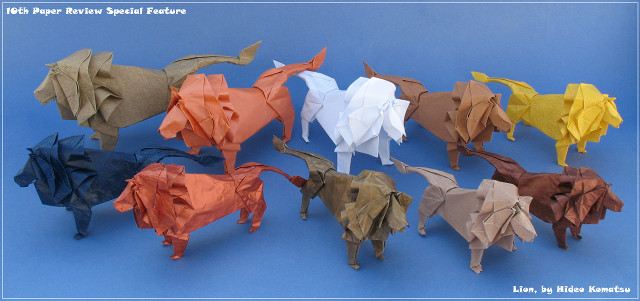
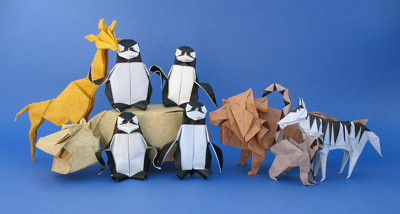
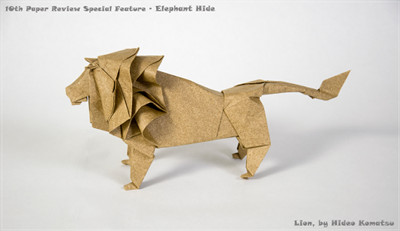
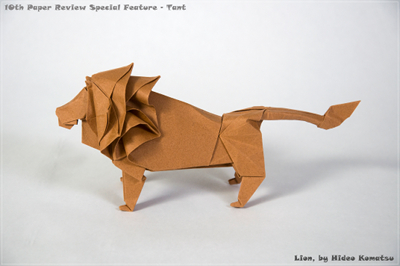
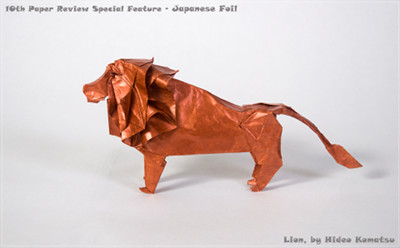
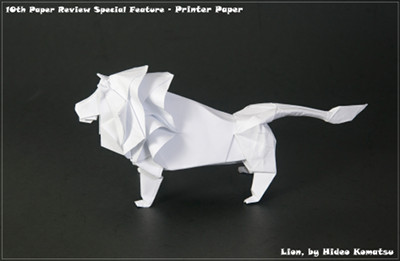
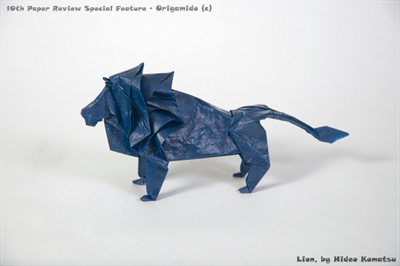
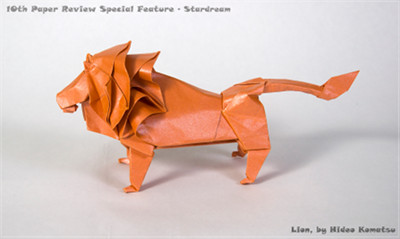
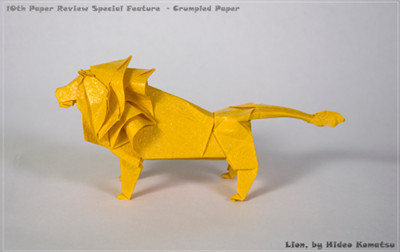
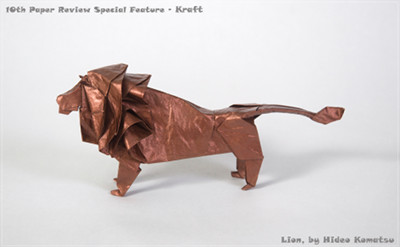
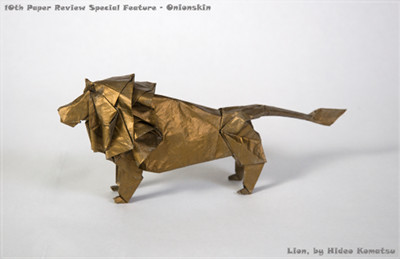
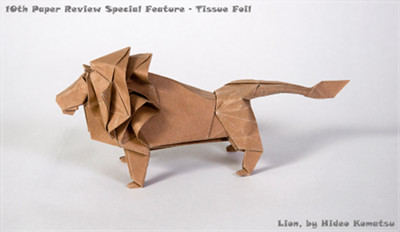
Comments
Submitted by Sara on 16 June 2012 - 9:01am Permalink
Lion by Hideo Komatsu
A crease pattern for the lion is available on Hideo Komatsu's site: http://www.origami.g...
Diagrams will be included in the upcoming book Works of Hideo KOMATSU (July 2012).
-- Sara
Submitted by dave t (not verified) on 18 June 2012 - 11:54pm Permalink
crease patterns
Do you think that would you ever make a video on how to go about tackling a crease patterm; maybe a few helpful hints or advice? Because there is whole new world of origami that would be accesable for me( and others who do not know how to fold cp's)if you could help.
Thanks
Add new comment